I have recently started reading the internet editions of Sindhi newspapers and I find the standard of journalism there at par, if not better than Urdu and English. While Urdu and English media gets all the attention, Sindhi press is lesser recognized.
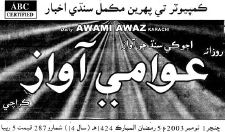
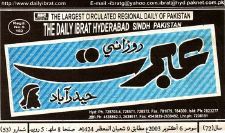
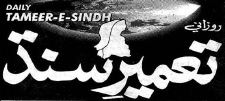
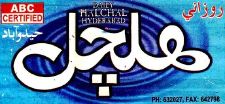
Sindhi newspapers cover all those items that one finds in national newspapers. Besides ‘aham khabrooN’ (important news), ‘wadheek khabrooN’ (more news) we can find business news, Showbiz, Sports, Editorials, cartoons, feature articles etc all in Sindhi newspapers. One obvious contrast between Urdu, English versus Sindhi newspapers however, is the news prioritization. Sometimes the headlines on Sindhi newspapers find a small place on back page of national dailies and vice versa.
On Irrigation Water Issues
One topic which I have consistently found appearing in bold in Sindhi newspapers is about the irrigation water. While Urdu press does not mention irrigation issues unless there is a flood or severe drought, water flow measurements at Sindh barrages make regular appearence in Sindhi news. Every few days I see a news item showing concern on depleting water levels at Guddu, Sukkur and desert like conditions downstream of Kotri. It shows that sharing of river water is a matter much more serious for Sindh than it gets its share on national media. This issue gets such a unanimous support in Sindhi press that I have not yet seen a single editorial in support of building new dams like Kalabagh etc. My guess is that in coming years, water sharing will become a major problem among provinces.
Who reads Sindhi Newspapers?
I believe the newspapers are alive and thriving because Sindhi is loved by the people who speak it and they prefer to get their news in Sindhi. Then there is another group of people whose mother tongue is not Sindhi but they like to read Sindhi newspapers in order to understand the regional perspective. I belong to this second group of people.
Sindhi newspapers also cater to the strong currents of Sindhi nationalism present in Sindh province.
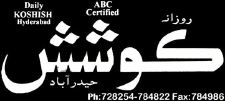
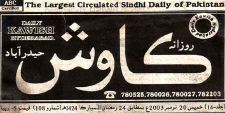

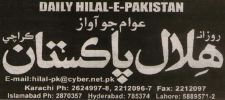
The Sindh-Punjab Equation
Another thing which I have noticed in Sindhi newspaper is their stress on the Sindh-Punjab comparison. It is not a secret that smaller provinces feel that they have to compete with the larger province in every social and economic field to maintain their historical and current provincial identity. This feeling is reflected in provincial newspapers also where almost all Sindhi newspapers try to dwelve on Sindh-Punjab comparison or try to show the picture where smaller provinces are not being treated fairly.
There is a strong need of bringing Sindhi and other provincial issues at National level to build consensus on them which in turn will strengthen national harmony. Currently many hot issues brew up and remain hidden from people in larger cities because Urdu and English media does not cover them as well as Sindhi newspapers do. Translating important news from Sindhi to Urdu/English and getting them prime real state on National dailies is the need of the hour. Here I must mention that the daily Dawn does give a weekly review of Sindhi newspapers in its features section.
Current State of Sindhi Press
More than fifteen daily Sindhi newspapers are published in Pakistan with Hyderabad being the largest center of such publications. Karachi and Sukkur follow suit. Largest circulation belongs to Kawish.
Ibrat newspaper has a leaning or a soft corner towards Pakistan Peoples Party. It is circulated more among politically conscious readership. Kawish on the other hand is more of an awami(public) newspaper and has a larger circulation. Kawaish has recently ventured into TV media also and KTV channel belongs to them.
Brief History of Sindhi Press
 The pioneers of journalism in Sindh were the Persian language newspapers. First Persian language newspaper started in Sindh in 1855. Its owner was Mirza Mukhlis Ali. In 1860, Mirza Mukhlis started a bilingual newspaper from Sukkur which printed one column in Persian and the other column contained its Sindhi translation. This newspaper was called ‘Matla Khursheed’ and is considered as the first Sindhi newspaper of the subcontinent. Matla Khursheed continued to publish until 1910.
The pioneers of journalism in Sindh were the Persian language newspapers. First Persian language newspaper started in Sindh in 1855. Its owner was Mirza Mukhlis Ali. In 1860, Mirza Mukhlis started a bilingual newspaper from Sukkur which printed one column in Persian and the other column contained its Sindhi translation. This newspaper was called ‘Matla Khursheed’ and is considered as the first Sindhi newspaper of the subcontinent. Matla Khursheed continued to publish until 1910.
The first Sindhi only newspaper was called ‘Moin-ul-Islam’ and it started its circulation in 1880. This was followed by various other papers such as Sind Sudhar, Muawan Majma, Saraswati, Aftab Sind, Kher Khoah, Musafir and Al Haq
The second period of Sindhi Journalism began with the publication of Al Hilal in 1901. The first Sindhi daily called Sind Wasi came out in 1908 and the second Hind Wasi in 1917. During this period a number of important papers were brought out which included Al Kashif, Al Ameen, Tauheed, Sitara-e-Sind and Subah Sind. This period culminated with publication of Al Waheed, the greatest Sindhi newspaper to date which was not only a newspaper but a movement and played a leading role in the establishment of Pakistan. Sheikh Abdul Majid Sindhi, Maulana Din Mohammad Wafai, Prof. Din Mohammad Alig, Pir Ali Mohammad Rashidi and Kazi Abdur Rehman were some of the stalwarts of journalism at the time who with their pens raised the consciousness of the people and made them aware of their rights.
Hilal-e-Pakistan began publication in 1946 at Hyderabad. It also mobilized people in favor of Pakistan. Hilal-e-Pakistan is probably the only Sindhi newspaper which has offices in Islamabad and Lahore also.
After independence of Pakistan several new papers came into existence, including Naeen Sind, Mehran, Azad, Nawai Sind.
List of current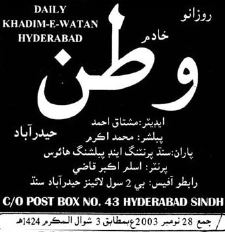 Sindhi Newspapers
Sindhi Newspapers
- Kawish, Hyderabad
- Ibrat, Hyderabad
- Hilal-e-Pakistan, Hyderabad
- Khadim-e-Watan
- Mehran, Hyderabad
- Awami Awaz, Karachi
- Nai Zindagi
- Parish
- Udhar
- Gulful
- Halar
- Sham
- Koshish
- Tameer-e-Sindh
- Halchal
- The Daily Nijat: Sukkur, Karachi
Reference:
(1) Material for “Brief History of Sindhi Newspapers” has been taken from an article “Sindhi Press in Pakistan” written by Shahida Mirza
(2) ‘aaj ka Sindh’ by Mahmood Mirza.




















































Dawn’s coverage of Sindhi news of the week:
http://www.dawn.com/2007/04/06/fea.htm#2
Adil
On a side note, While Sindhi press is increasing its circulation, Gujrati press is on the decline. Until say 15 years ago seeing Dawn’s Gujrati edition used to be a common sight but not anymore. Parsi community in Karachi was the most loyal readers of Gujrati newspapers. Their readership number is dwindling or atleast not increasing. The 3rd or 4th generation of people whose parents migrated from Indian Gujrat in 1947 doesn’t know how to read or write Gujrati. For all practical purposes (and thus in news media also) Urdu is now the lingua-franca. I am proud that Urdu has come this far and it is the one medium in which all Pakistanis can communicate but it has indeed come at the expense of declining regional languages.
Dear Adil, the reason Sindhi has very vibrant press is that Sindhi has long history and tradition of imparting education in Sindhi. The script for Sindhi language was developed by British more than a century ago. Since then from judicial system to revenue and from literature to agriculture, Sindhi language has been used. Before partition almost whole Bengali literature and a major portion of English literature was translated in Sindhi. Books on almost every subjects are available in Sindhi. Even today hundreds of books in Sindhi are published on subjects from history to religion and from science to medicine. Sindhi newspapers have loyal readership of more than two hundred thousand ( Two lakhs) readers. There are four channels in Sindhi and more are coming. There are about seven FM Radio station airing content in Sindhi. Sindhi has also significant presence on internet.
I am thinking on having a post on languages of Pakistan on net. Any suggestions?
Adil,
The obvious answer is that Sindhi language is more developed than other regional languages.
Years ago I did a detailed study (resulting in a short booklet) on media in Pakistan that reviewed circulations, impacts, etc. One think that stood out was just how vibrant the Sindhi and the Gujarati newspapers were but there were NO local language newspapers in other languages. part of this can be literacy. But only a part. Any ideas on what might explain this?